New publications
How Nicotinamide and Green Tea "Trigger" Self-Cleansing in Alzheimer's Disease
Last reviewed: 09.08.2025

All iLive content is medically reviewed or fact checked to ensure as much factual accuracy as possible.
We have strict sourcing guidelines and only link to reputable media sites, academic research institutions and, whenever possible, medically peer reviewed studies. Note that the numbers in parentheses ([1], [2], etc.) are clickable links to these studies.
If you feel that any of our content is inaccurate, out-of-date, or otherwise questionable, please select it and press Ctrl + Enter.

Scientists from the GeroScience Institute (R.A. Santana, J.M. McWhirt, G.J. Brewer, and colleagues) found that guanosine triphosphate (GTP) deficiency in aging neurons interferes with the removal of toxic β-amyloid plaques, and a combination of nicotinamide and the polyphenol EGCG from green tea restores GTP stores, “resets” endocytosis and autophagy, and protects cells from death. The study is published in the journal GeroScience.
Why is this important?
In Alzheimer's disease (AD), aggregates of β-amyloid (Aβ) accumulate in the brain, disrupting synapses and leading to neuronal death. Until now, most therapeutic efforts have aimed to directly destroy Aβ or protect neurons from its associated toxic effects. New work opens up an alternative route: adjusting the energy balance of neurons to restore their ability to cleanse themselves.
GTP deficiency inhibits clearance
- Role of GTP: In addition to ATP, GTP is required for the function of GTP-active GTPases (e.g. Rab7, Arl8b) that regulate intracellular transport and phago-/endocytosis.
- Age-related changes: With aging and in the 3×Tg-AD transgenic mouse model, free GTP stores in hippocampal neurons decline, disrupting Rab7 and Arl8b function and blocking autophagic flux.
Laboratory research
GEVAL Sensor: Using the genetically programmed GEVAL sensor, the researchers measured GTP/GDP levels in living neurons in real time. In old cells, the GTP/GDP ratio was 40–50% lower than in young cells.
Modulation of phago- and endocytosis:
Rapamycin (an autophagy stimulator) unexpectedly further reduced GTP, exacerbating the energy crisis and accelerating cell death.
Bafilomycin (a lysosomal fusion inhibitor) increased GTP but blocked clearance, which also harmed neurons.
Return to youth with the help of molecules:
- Incubation of aged neurons for 16 h with 2 mM nicotinamide (NAD⁺ precursor) and 2 µM EGCG from green tea restored GTP levels to those of young cells.
- This resulted in the activation of Rab7-mediated endocytosis and Arl8b-dependent autophagy, resulting in:
- Significant removal of intracellular Aβ aggregates,
- Improving neuronal survival by 30–40%,
- Reduction of oxidative stress markers (protein nitration).
Authors' Quotes
"We have shown that age-related GTP deficiency in neurons is not an irreversible part of aging, but a treatable target. Its restoration literally 'reboots' phagocytosis and endocytosis, allowing cells to get rid of toxins on their own," comments study leader Dr. Ricardo Santana.
“EGCG and nicotinamide are already being used in the clinic, and it is now clear how their combination can directly influence neuronal proteostasis and potentially slow or even reverse the progression of AD,” adds co-author Professor James McWhirt.
The authors particularly highlight three key points:
GTP Deficiency as a Reversible Target
“Early stages of Alzheimer’s disease appear to be characterized by a functional deficit in GTP energy rather than complete neuronal death,” notes Dr. Ricardo Santana. “By restoring GTP, we essentially ‘reset’ the cellular self-cleaning mechanisms and give neurons a chance to survive.”The Synergy of Nicotinamide and EGCG
“Nicotinamide is involved in NAD⁺ regeneration and indirectly supports GTP biosynthesis, while EGCG activates antioxidant pathways via Nrf2,” explains Prof. James McWhirt. “Their combination had a surprisingly powerful effect on restoring autophagy and endocytosis.”Fast track to the clinic
“Both components are already in clinical use and have a favourable safety profile,” adds Dr Grant Brewer. “This opens up the real possibility of testing in patients with early symptoms to confirm our preliminary findings and move quickly to therapy.”
Prospects for clinical application
- Available ingredients: Nicotinamide and EGCG are listed as safe food additives, facilitating the transition to clinical trials.
- Trial program: Scientists are planning pilot studies in patients in the early stages of AD to evaluate dosage, duration of treatment and tolerability.
- Novel therapeutic targets: Restoring neuronal GTP energy may complement existing approaches targeting Aβ and tau pathology, creating comprehensive treatment strategies.
Conclusion: This study identifies GTP-energy deficiency as a key reversible cause of toxic protein accumulation and proposes a molecular “key”—a combination of nicotinamide and EGCG—to restore neuronal self-cleaning and protect against neurodegeneration.
